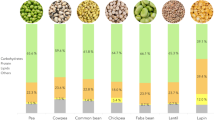Abstract
In the present study, the baking properties of the pseudocereals amaranth, quinoa and buckwheat as potential healthy and high-quality ingredients in gluten-free breads were investigated. Scanning electron micrographs were taken of each of the flours. The pasting properties of these flours were assessed using a rapid visco analyser. Standard baking tests and texture profile analysis were performed on the gluten-free control and pseudocereal-containing gluten-free breads. Confocal laser scanning microscopy (CLSM) images were also obtained from the baked breads and digital image analysis was conducted on the bread slices. Bread volumes were found to significantly increase for the buckwheat and quinoa breads in comparison with the control. In addition, the pseudocereal-containing breads were characterised by a significantly softer crumb texture effect that was attributed to the presence of natural emulsifiers in the pseudocereal flours and confirmed by the confocal images. No significant differences were obtained in the acceptability of the pseudocereal-containing gluten-free breads in comparison with the control.






Similar content being viewed by others
References
Catassi C, Fasano A (2008) In: Arendt EK, Dal Bello F (eds) Gluten-free cereal products and beverages. Academic Press, London
Kupper C (2005) Dietary guidelines and implementation for celiac disease. Gastroenterol 128:S121–S127
Case S (2005) The gluten-free diet: how to provide effective education and resources. Gastroenterol 128:S128–S134
Pietzak M (2005) Follow-up of patients with celiac disease: achieving compliance with treatment. Gastroenterol 128:S135–S141
Gallagher E, Gormley TR, Arendt EK (2004) Recent advances in the formulation of gluten-free cereal-based products. Trends Food Sci Technol 15:143–152
Arendt EK, Morrisey A, Moore MM, Dal Bello F (2008) In: Arendt EK, Dal Bello F (eds) Gluten-free cereal products and beverages. Academic Press, London
Thompson T (1999) Thiamin, riboflavin, and niacin contents of the gluten free diet: is there cause for concern? J Am Diet Assoc 99:858–862
Thompson T (2000) Folate, Iron, and dietary fiber contents of the gluten-free diet. J Am Diet Assoc 100:1389–1395
Thompson T, Dennis M, Higgins LA, Lee AR, Sharrett MK (2005) Gluten-free diet survey: are Americans with coeliac disease consuming recommended amounts of fibre, iron calcium and grain foods? J Hum Nutr Diet 18:163–169
Alvarez-Jubete L, Arendt EK, Gallagher E (2009) Nutritive value and chemical composition of pseudocereals as gluten-free ingredients. Int J Food Sci Nutr 60(suppl 4):240–257
Berghofer E, Schoenlechner R (2002) In: Belton PS, Taylor JRN (eds) Pseudocereals and less common cereals: grain properties and utilization potential. Springer, Berlin
Alvarez-Jubete L, Wijngaard HH, Arendt EK, Gallagher E (2010) Polyphenol composition and in vitro antioxidant activity of amaranth, quinoa and buckwheat as affected by sprouting and bread baking. Food Chem 119:770–778
Taylor JRN, Parker ML (2002) In: Belton PS, Taylor JRN (eds) Pseudocereals and less common cereals: grain properties and utilization. Springer, Berlin
Wijngaard HH, Arendt EK (2006) Buckwheat. Cereal Chem 83:391–401
Alvarez-Jubete L, Holse M, Hansen A, Arendt EK, Gallagher E (2009) Impact of baking on the vitamin E content of the pseudocereals amaranth, quinoa and buckwheat. Cereal Chem 86(5):511–515
ICC (1976) Standard methods. International Association for Cereal Chemistry, Vienna
Wijngaard HH, Renzetti S, Arendt EK (2007) Microstructure of buckwheat and barley during malting observed by confocal laser scanning microscopy and scanning electron microscopy. J Inst Brew 113:34–41
Lindeboom N, Chang PR, Falk KC, Tyler RT (2005) Characteristics of starch from eight quinoa lines. Cereal Chem 82:216–222
Qian J, Kuhn M (1999) Characterization of Amaranthus cruentus and Chenopodium quinoa starch. Starch Stärke 51:116–120
Qian J, Rayas-Duarte P, Grant L (1998) Partial characterization of buckwheat (Fagopyrum esculentum). Starch Cereal Chem 75:365–373
Schoenlechner R, Siebenhandl S, Berghofer E (2008) In: Arendt EK, Dal Bello F (eds) Gluten-free cereal products and beverages. Academic Press, London
Wright KH, Huber KC, Fairbanks DJ, Huber CS (2002) Isolation and characterization of Atriplex hortensis and sweet Chenopodium quinoa starches. Cereal Chem 79:715–719
Hunjai C, Wansoo K, Malshick S (2004) Properties of Korean Amaranth starch compared to waxy millet and waxy sorghum starches. Starch Starke 56:469–477
Yoshimoto Y, Egashira T, Hanashiro I, Ohinata H, Takase Y, Takeda Y (2004) Molecular structure and some physicochemical properties of buckwheat starches. Cereal Chem 81:515–520
Gallagher E, Gormley TR, Arendt EK (2003) Crust and crumb characteristics of gluten-free breads. J Food Eng 56:153–161
Scanlon MG, Zghal MC (2001) Bread properties and crumb structure. Food Res Int 34:841–864
Adekunle Ayo J (2001) The effect of amaranth grain flour on the quality of bread. Int J Food Prop 4:341–351
Chauhan GS, Zillman RR, Eskin MA (1992) Dough mixing and breadmaking properties of quinoa-wheat flour blends. Int J Food Sci Technol 27:701–705
Park SH, Morita N (2005) Dough and breadmaking properties of wheat flour substituted by 10% with germinated quinoa flour. Food Sci Technol Int 11:471–476
Samiyi M, Ashraf HL (1993) Iranian breads supplemented with amaranth flour. Int J Food Sci Technol 28:625–628
Moore MM, Schober TJ, Dockery P, Arendt EK (2004) Textural comparisons of gluten-free and wheat-based doughs, batters, and breads. Cereal Chem 81:567–575
Schober T (2009) In: Gallagher E (ed) Gluten-free food science and technology. Wiley-Blackwell, Oxford
Gan Z, Ellis PR, Schofield JD (1995) Gas cell stabilisation and gas retention in wheat bread dough. J Cereal Sci 21:215–230
Przybylski R, Chauhan GS, Eskin NAM (1994) Characterization of quinoa (Chenopodium quinoa) lipids. Food Chem 51:187–192
Gamel TH, Mesallam AS, Damir AA, Shekib LA, Linssen JP (2007) Characterization of amaranth seed oils. J Food Lipids 14:323–334
Mazza G (1988) Lipid content and fatty acid composition of buckwheat seed. Cereal Chem 65:122–126
Hoseney RC (1998) Principles of cereal science and technology. AACC International, St. Paul
Belitz HD, Grosch W, Schieberle P (2004) Food chemistry. Springer, Berlin
Acknowledgment
The present study is financially supported by Enterprise Ireland.
Author information
Authors and Affiliations
Corresponding author
Rights and permissions
About this article
Cite this article
Alvarez-Jubete, L., Auty, M., Arendt, E.K. et al. Baking properties and microstructure of pseudocereal flours in gluten-free bread formulations. Eur Food Res Technol 230, 437–445 (2010). https://doi.org/10.1007/s00217-009-1184-z
Received:
Revised:
Accepted:
Published:
Issue Date:
DOI: https://doi.org/10.1007/s00217-009-1184-z




